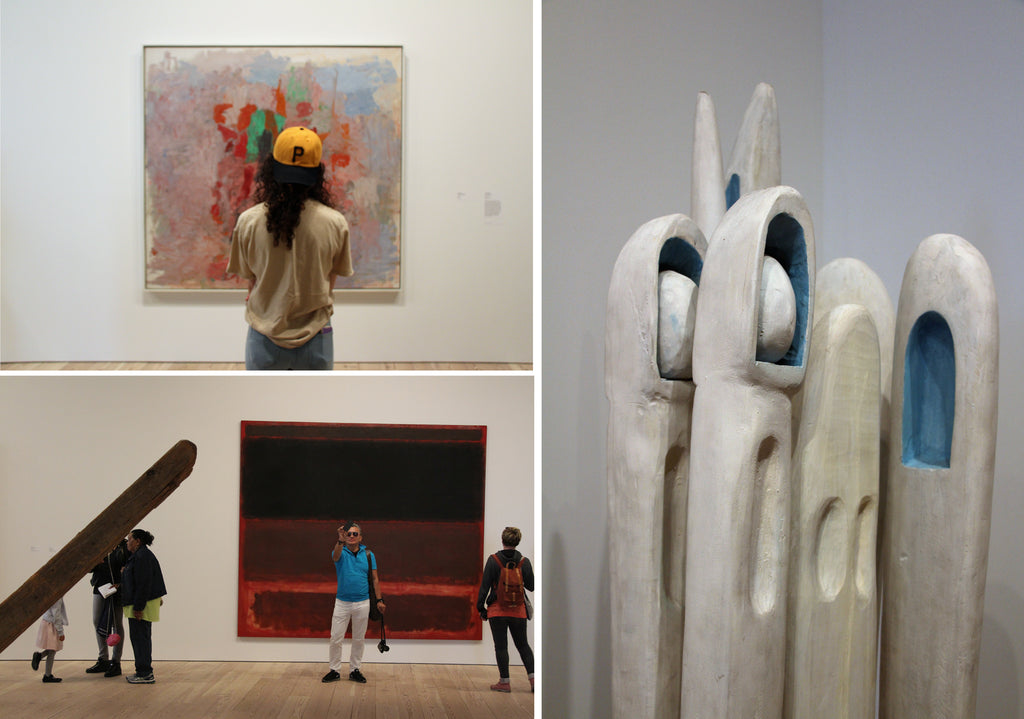

Last Saturday the brand new Whitney Museum opened its downtown doors (for free!) at their new 99 Gansevoort Street digs.
Overlooking the Hudson River, architect Renzo Piano created dynamic viewpoints where anywhere you turned held stunning vistas of angulated terraces suspended over the High Line and street party below.
Here's a glimpse from our perspective of just a few things that turned us in the 50,000 sprawling sq ft of gallery and of the 13,000 sq ft of aspirational outdoor space. Well, we have a lot to aspire to here for Fiercely Curious!

Abstraction, 1926 and Music, Pink and Blue No. 2 both of course by Georgia O'Keeffe.

Post WWI, industry never looked so modern! Calder's mobile softly churns to the beat of the machinery below.

My Egypt, 1927 by Charles Demuth and Hanging Spider, 1940 by Alexander Calder

Jewelled City, 1931 by Gerald K. Geerlings

Pittsburgh, 1927 by Elsie Driggs (and man with quite stylish hair).
This day was a photographer's delight, where cameras were welcomed and the stylish crowd en masse got the memo and silently shifted out of your shot giving you creative priority or remain in it, sensing they were the subject of your composition.

Rose Castle, 1945 by Joseph Cornell.
Woodblock prints of watercolors, 1928-30 by Chiura Obata.
Marrying traditional Japanese painting techniques with Western contemporary art, Chiura Obata's woodblock prints took him nearly 2 years to complete requiring more than 100-200 hand colored woodblock impressions with dozens of blocks to create just one brushstroke.

Calder’s Circus, 1926–31by Alexander Calder. (Separately, it appears a lioness has escaped her den).

Dial, 1956 by Philip Guston, Quarantania, 1941 by Louise Bourgeois, Four Darks in Red, 1958 by Mark Rothko.

Door to the River, 1960 by Willem De Kooning.


Opening day street party below and art al aperto.

I call this setting boundaries, he calls it Untitled, 1966 by Donald Judd.

Rational Irrationalism, 1969 by Alvin Loving. Five, 1967 by Thomas Downing.

"The farmers in California and elsewhere were being terribly exploited at the time, and it became a national scandal. And there was a significant movement where people stopped eating grapes as a protest to these conditions". Milton Glaser.
Don't Eat Grapes, 1969 by Milton Glaser.

Referencing 1780s slave ship diagrams, Malcolm Bailey's blueprint style painting includes a drawing of a cotton plant - the driving force behind slave labor.
Untitled 1969, 1969 by Malcolm Bailey.

Three Flags, 1958 by Jasper Johns.

Saigon, 1967 by Peter Saul. Women and Dog, 1963-64 by Marisol.


Our favorite piece. This massive body of work took yes, 8 yrs to create and the 1,500 pound piece is almost completely made of layer upon layer of thick paint. With wooden dowels for support, DeFeo built The Rose up, carved it back and the did that over and over again. The piece needed to be removed from her second story studio with a forklift through a partially dismantled window.
The Rose, 1958-66 by Jay DeFeo.

Whites, 1963 sculpture by Ellsworth Kelly. Atlantic, 1956 painting by Ellsworth Kelly. Blanco y Verde, 1959 by Carmen Herrara. Plum Nellie, Sea Stone, 1972 by Robert Reed. Die Fahne hoch!, 1959 by Frank Stella.

Phil, 1969 by Chuck Close (enjoyed by well heeled and happy about town folks). Acrylic and graphite on canvas. No joke.

Untitled, 1968 by Cy Twombly. Oil and crayon on canvas.


Artist unknown...drop me a line if you find out!


To be appreciated by kids of all ages.
Vivre le American art...it doesn't get better than this!
Thanks Whitney Museum for an inspired day!
xxE&T
Keep up to date with all things Fiercely Curious:
